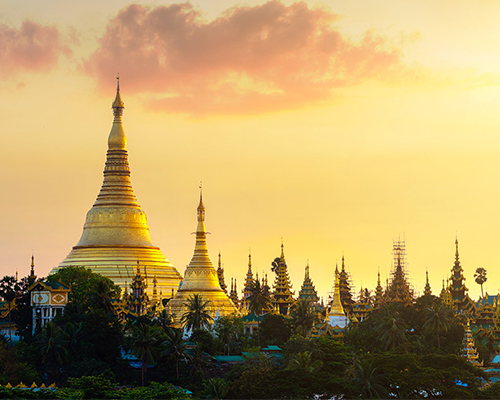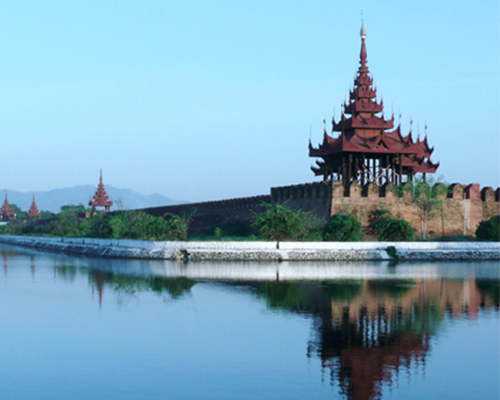Mandalay and It's Environs
MANDALAY, the last Capital of Myanmar Kingdom is located in the central plain of Myanmar. Once known as the Yadanabon Kingdom, The Palace City founded by King Mindon in 1857 AD. During the rule of King Thibaw, the entire Myanmar fell into British. Today this city is becoming the commercial center, loaming from North to South and East to West of Myanmar, trades by China, Thailand, India, Bangladesh and Yangon seaport.
Culture Center
 The city remains as traditional culture center of Myanmar, because many crafts works, Tapestry works, Myanmar Art and literatures are flourished in Kongbaung Period of Mandalay is still remain as traditional culture center of Myanmar. Mandalay Palace and Monasteries are all decorated with traditional crafts and Myanmar scriptures can be seen on many of the marble slabs laid on Pagodas and some Monasteries is reflected as a culture center of Myanmar.
The city remains as traditional culture center of Myanmar, because many crafts works, Tapestry works, Myanmar Art and literatures are flourished in Kongbaung Period of Mandalay is still remain as traditional culture center of Myanmar. Mandalay Palace and Monasteries are all decorated with traditional crafts and Myanmar scriptures can be seen on many of the marble slabs laid on Pagodas and some Monasteries is reflected as a culture center of Myanmar.
Maha Myatmuni Buddha Image (Pagoda)
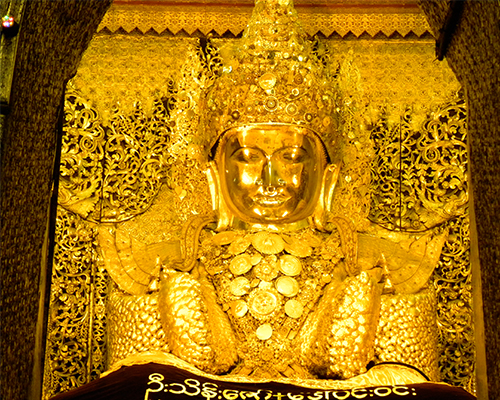 The MaharMyat Muni Buddha Image is the most revered Buddha image in Mandalay. It is also known as the PhayaGyi. The MaharMyat Muni Pagoda is located at the Southwest of Mandalay city and the most famous Buddha image which was transported to Mandalay from Mrauk U in 1784. It was believed to be of great age even at that time – it may have been cast during the 1st century AD. 4 meter high seated image is cast in bronze , but over the years thousands of devout Buddhists have completed covered the figure in 15cm thick layer of gold and some other precious stones, such as rubies, jades, sapphires, diamonds, pearls, emeralds, etc. The image is completely covered with 15cm thick gold donated by locals from all over the country. The Maha Muni is said to be the biggest of the four Munis. It is the most ancient Buddha image in Myanmar. It was cast in the life-span of Lord Buddha in the seated posture of relaxed deportment, namely BumiPhasa Mudras, symbolic of His Conquest of Mara. The 4m high-seated image is cast in bronze and weigh 6.5 tons, which it’s crown is decorated with diamonds, rubies, and sapphires. MaharMyat Muni Buddha Image was being cast in front of the Buddha himself it can say MaharMyat Muni Buddha Image is the portrait of Buddha and the face is most revered. Every morning at 4:30AM, a team of monks washes the face and brushes the teeth. Since Myanmar Buddhists are so devout countless thousands of devotees apply gold leaf to gain merit, the image has completely covered with 15 cm thick gold and original shape is distorted.
The MaharMyat Muni Buddha Image is the most revered Buddha image in Mandalay. It is also known as the PhayaGyi. The MaharMyat Muni Pagoda is located at the Southwest of Mandalay city and the most famous Buddha image which was transported to Mandalay from Mrauk U in 1784. It was believed to be of great age even at that time – it may have been cast during the 1st century AD. 4 meter high seated image is cast in bronze , but over the years thousands of devout Buddhists have completed covered the figure in 15cm thick layer of gold and some other precious stones, such as rubies, jades, sapphires, diamonds, pearls, emeralds, etc. The image is completely covered with 15cm thick gold donated by locals from all over the country. The Maha Muni is said to be the biggest of the four Munis. It is the most ancient Buddha image in Myanmar. It was cast in the life-span of Lord Buddha in the seated posture of relaxed deportment, namely BumiPhasa Mudras, symbolic of His Conquest of Mara. The 4m high-seated image is cast in bronze and weigh 6.5 tons, which it’s crown is decorated with diamonds, rubies, and sapphires. MaharMyat Muni Buddha Image was being cast in front of the Buddha himself it can say MaharMyat Muni Buddha Image is the portrait of Buddha and the face is most revered. Every morning at 4:30AM, a team of monks washes the face and brushes the teeth. Since Myanmar Buddhists are so devout countless thousands of devotees apply gold leaf to gain merit, the image has completely covered with 15 cm thick gold and original shape is distorted.
Sightseeing around Mandalay
Amarapura
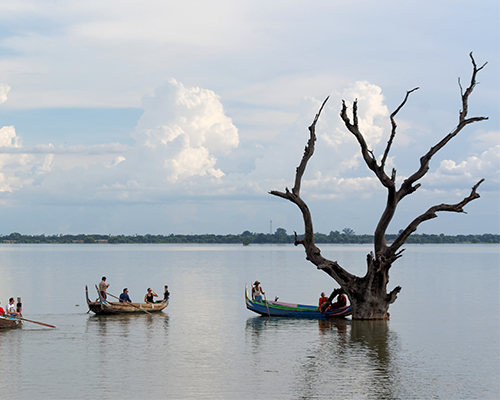
Amarapura is an ancient capital of Konbaung Dynasty, 11 km south of Mandalay. Phatodawgyi Pagoda, U Bein Bridge (1208) meters across Taungthaman Lake built by the Mayor U Bein with teak planks two centuries ago, cotton and silk weaving workshop are places of interest to visit. The Mahagandhayon Monastery is the largest Buddhist monastery in Myanmar accommodating more than a thousand young monks. It is a typical place to witness the disciplined way of life of Buddhist monks. Distinguish character of this large monastery is the systematic manner of the monks during the lunchtime, having their meal in total silence and systematically in accordance with Buddha’s teachings.
Mingun Bell
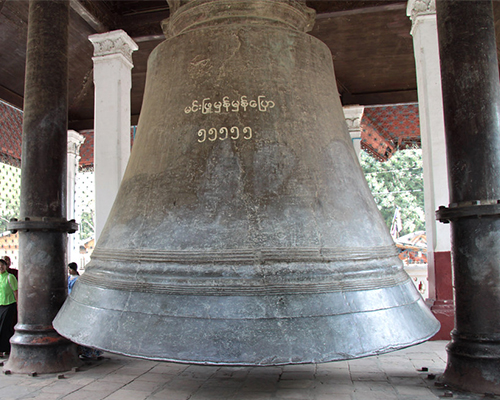
On the west bank of Mandalay about 11 km, is a small town, well known for its world largest ringing bell weights 90.5 ton is at the height of 12ft and the diameter of the mouth is 16ft wide was cast by the lost-wax process on Nandaw Island, and commissioned by King Bodawpaya in 1970 for his new big pagoda. It was transported across the Ayeyarwaddyriver on two boats. The bell was originally hung on teak uprights, but these gave away during the 1838 earthquake. It is said the largest un-cracked bell in the world – the biggest although flawed, is in Moscow.
Pahtodawgyi
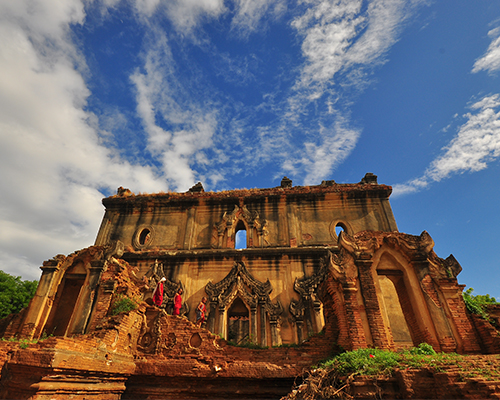
The big incomplete temple, built by King Bodawphaya in late 1790. It took 15 years to build and the king died before completed it. Instead of 530ft in height is at present is only 162ft high. From the upper terrace of the building can see the yawning cracks cutting deep down into the solid base. It was the damages caused by many earthquakes in 1838. Two mythical lions in front of the building are at the height of 95ft and the eyes were 9ft in width. The huge remnants of the Pagoda and mythical lions still testify the archaeological skills of the Amarapura period.
Sagaing
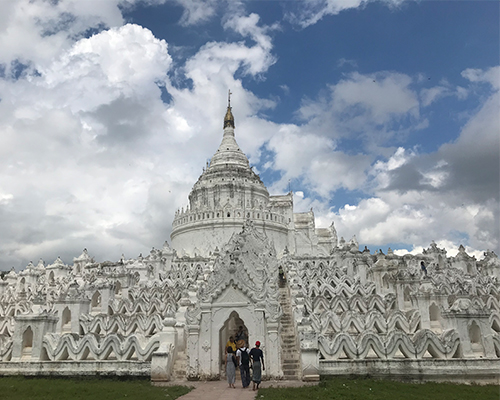
Son of Pinya King Minnanthu known as AthinkhayaSawyun built the Kingdom city in 1315 AD. This city situated on the northwest of Mandalay on the west bank of Ayayarwaddy River about 21 km from Mandalay. There are about 6ooo Monasteries and many ancient Pagodas spotted on the west bank of Ayarwaddy in Sagaing hills. KaungHmudaw, U Min Thoneze, Ponyashin Pagodas are main attractions in Sagaing hill.
Innwa
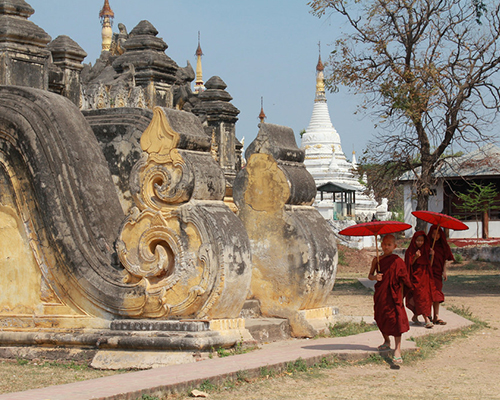
Innwa was also known as Ava in the ancient times. Innwa was the capital of Myanamr from 1364-1841. Prior to this, Sagaing had been the capital, but after Sagaing fell to the Shan, the court moved across the river to Innwa. The kings of Innwa set about restoring Burmese. After the British conquered Lower Myanmar, after the Second Anglo-Burmese War, Upper Myanmar was commonly called the Kingdom of Innwa. During the reign of King Bodawpaya (1781-1819), the capital was moved to nearby Amarapura. However, his successor, King Bagyidaw (1819-1837), moved the Court back to Innwa in 1823. When a tremendous earthquake caused extensive damage in 1841, Innwa was finally abandoned for Amarapura. Little remains of the ancient capital today. The Watch Tower, about 90ft (30m) high is the only masonry building left on the King Bagyidaw’s Palace built in 1822. The tower was left leaning to one side after an earthquake in 1838 but it was restored as its original structure. This is one of the Myanmar architectural styles of early 19th Century. Mae Nu Okkyaung Monastery, was built by King Bagyidaw’s chief queen for the royal abbot NyaungganSayardaw in 1818. It was Construct by brick and stucco, its design simulates that of wooden monasteries, which multiple roofs and a prayer hall with a 7-tiered superstructure. It has fine decorations and carving. Bargayar Monastery: The grand Bargaya monastery is built entirely with teak wood and decorated with splendid Myanmar architectural works. The entire monastery is built of teak and consists of 267 teak pillars (the largest measures 18 m in height and 2.7 m in circumference). All these places to be visited by horse carts which is amazing experience by the quiet and peacefulness, the different landscapes and the ruins of the ancient temples.
Pinya
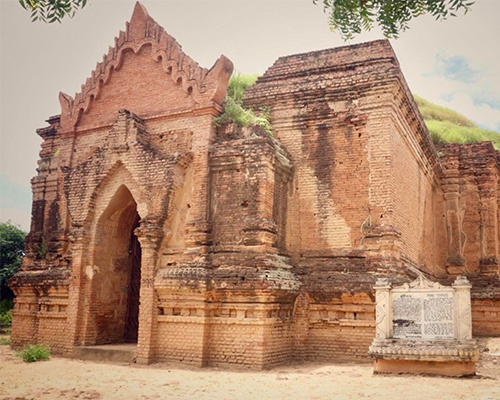
Three Shan brothers built Pinya City in 1312 AD. Pinya era started from the fall of Bagan. This era lasted about 52 years. There are five rulers, started from ThiHaThu, Uzana, NgazishinKyawzwa, Narathu and UzanaPyaung. The first king (ThihaThu) built Pinya City State. But his son AthinKhaYaSawYun moved to Sagaing and became king of Sagaing. Then became the rival City States. Pinya after 40 years of rule fell from it’s power and Sagaing became powerful. After the fall of Pinya and Sagaing, there came another City State call Innwa, the last king of Pinya named ThadoMinPhya as the king of Innwa and built the Innwa City, his rule lasted about 4 months and then moved back to Pinya. During the rules of the kings, they built Pagodas for their religious deeds. Many brave kings and famous literatures from Pinya age can be seen on the stone scripts round the Pagodas.
Monywa
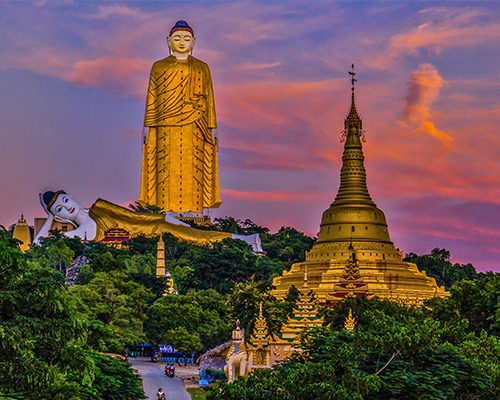
About 136km to the west from Mandalay is Monywa. The city is on the east bank of Chindwin River and hub of trade and commerce in the Chindwin Valley. Monywa is famous for its MohnyinThanboddhay Pagoda complex, with more than five hundred thousand Buddha Images in it. The land of One thousand Bo trees can also observe on the land of I 37 acres, with a huge reclining Buddha Image on the hill slope is about 333ft long beyond the trees.
Phowin and Shweba Hill
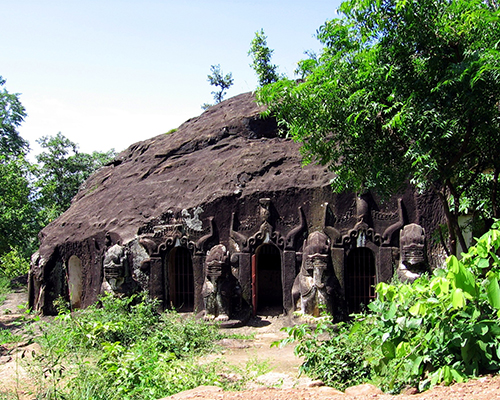
Crossing the Chindwin rive and taking one hour drive, on the west bank about 30km, there are famous rocky Phowin and Shweba hills with big niches and huge Buddha Images with fine roundabout steps carved out of the single rocky hills are from centuries age and worth for visiting.
Pyin Oo Lwin
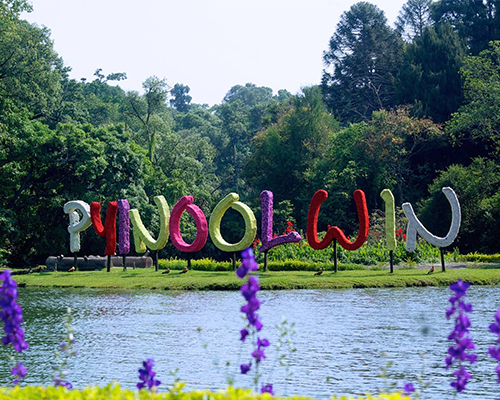
Pyin Oo Lwin offers visitors cool days and nights, peaceful rural roads and tracks for walkers and cyclists, trekking in the fruit and flower producing countryside, and interesting shopping. Old times can be re-lived with coach rides, and many historical and beautiful places are within easy reach. Just over an hour’s drive from Mandalay, and with spectacular views from the road up the escarpment, Pyin Oo Lwin is an ideal and refreshing destination for visitors to Upper Myanmar. It’s surrounded by low hills within an area of approximately 30sq.km, the area is dotted with pine trees; eucalyptus and silver oak, coffee, vegetables and strawberries are grown on the slopes of the hills. Sweater-knitting is the biggest occupation in town. Getting around PyinOoLwin can be enjoyable; the standard transport around is a miniature, enclosed wagon pulled by a pony.
Goteik viaduct
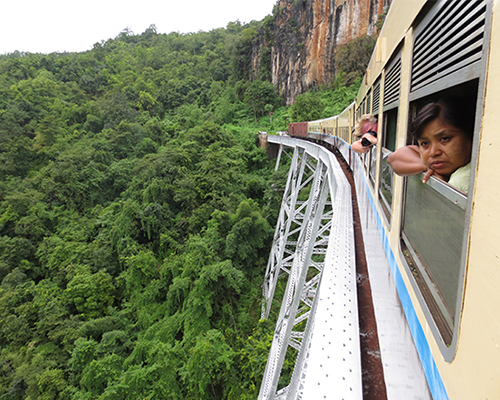
The Goteik viaduct is a railway trestle in Nawnghkio, western Shan State, Myanmar (Burma). The bridge is between the two towns of Pyin U Lwin, the summer capital of the former British colonial administrators of Burma, and Lashio, the principal town of northern Shan State. It is the highest bridge in Myanmar and when it was completed, the largest railway trestle in the world. The rail line was constructed as a way for the British Empire to expand their influence in the region. It was finally renovated recently. Its age shows; even the trains slow to crawl when crossing the viaduct to lessen undue stress on the structure. It is one of the excited experiences.

